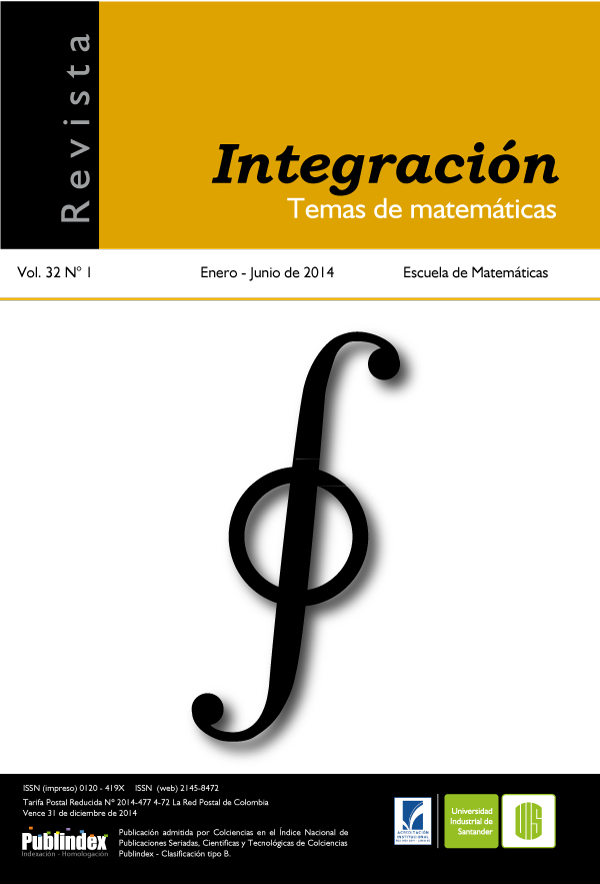Uni-bimodal Symmetric-Asymmetric Model with Application to the Study of HIV-1 RNA
Published 2014-05-22
Keywords
- Bimodality,
- skewness,
- kurtosis,
- proportional hazard function,
- censorship
- limit of detection,
- HIV-1 RNA,
- HAART. ...More
How to Cite
Abstract
We define two new probability distributions, unibimodal symmetric model with proportional hazard function to the normal distribution and unibimodal asymmetric model with proportional hazard function to the skew normal distribution. These models allow adjust censored data with bimodal behavior and high (or low) levels of kurtosis compared with kurtosis of the normal distribution and high (or low) levels of asymmetry. The model parameters are estimated by maximum likelihood and the observed information matrix is determined. The flexibility of the new distribution is illustrated by adjusting a set of real data, the number of molecules of HIV-1 RNA per milliliter of blood measured in individuals with confirmed test of the presence of HIV.
To cite this article: G. Martínez-Flórez, G. Moreno-Arenas, Modelo unibimodal simétrico-asimétrico con aplicación al estudio del RNA VIH-1, Rev. Integr. Temas Mat. 32 (2014), no. 1, 1–18.
Downloads
References
- Amplicor HIV-1 MONITOR R . Test, version 1.5, Branchburg, NJ: Roche Molecular Systems, Inc., 2002.
- Arnold B., Gómez H. and Salinas H., “On multiple constraint skewed models”, Statistics 43 (2009), no. 3, 279–293.
- Azzalini A. “A class of distributions which includes the normal ones”, Scandinavian Journal of Statistics 12 (1985), 171–178.
- Biomarkers Definitions Working Group: Biomarkers and surrogate endpoints. Preferred definitions and conceptual framework. Clin. Pharmacol. Ther. 69 (2001), 89–95.
- Chiogna M., “Some results on the scalar skew-normal distribution”, Journal of the Italian Statistical Society 1 (1998), 1–14.
- COBAS R AmpliPrep/COBAS R TaqMan R HIV-1 Test, version 2.0. Branchburg, NJ: Roche Molecular Systems, Inc., 2010.
- Cordeiro G. and de Castro M., “A new family of generalized distributions”, J. Statist. Comput. Simul. 81 (2012), 883–898.
- Durrans S.R., “Distributions of fractional order statistics in hydrology”, Water Resources Research 28 (1992), no. 6, 1649–1655.
- Gómez H., Venegas O., and Bolfarine H., “Skew-symmetric distributions generated by the distribution function of the normal distribution”, Environmetrics 18 (2007), 395–407.
- Gómez H., Elal-Olivero D., Salinas H., and Bolfarine H., “Bimodal extension based on the Skew-Normal distribution with application to pollen data”, Environmetrics 22 (2009),
- –62.
- Hartigan J.A. and Hartigan P.M., “The dip test of unimodality”, Ann. Stat. 13 (1985), 70–84.
- Hartigan P.M., “Computation of the dip statistics to test for unimodality”, Appl. Stat. 34 (1985), 320–325.
- Henze N., “A probabilistic representation of the skew-normal distribution”, Scandinavian Journal of Statistics 13 (1986), 271–275.
- Kim H., “On a class of two-piece skew-normal distribution”, Statistic 39 (2005), no. 6, 537–553.
- Li X., Chu H., Gallant J., Hoover D., Mack W., Chmiel J., and Muñoz A., “Bimodal virological response to antiretroviral therapy for HIV infection: an application using a mixture model with left censoring”, Journal Epidemiol. Community Health 60 (2006), no. 9, 811–818.
- Lim T., Bakri R., Morad Z., and Hamid M., “Bimodality in blood glucose distribution. Is it universal?”, Diabetes Care 25 (2002), 2212–2217.
- O’Hagan A. and Leonard T., “Bayes estimation subject to uncertainty about parameter constraints”, Biometrika 63 (1976), 201–203.
- Pewsey A., “Problems of inference for Azzalini’s skew-normal distribution”, Journal of Applied Statistics 27 (2000), no. 7, 859–870.
- R Development Core Team, R: A Language and Environment for Statistical Computing, R Foundation for Statistical Computing, Vienna, Austria, 2012.
- Stasinopoulos M.D. and Rigby R.A., “Generalized Additive Models for Location Scale and Shape (GAMLSS) in R”, Journal of Statistical Software 23 (2007), no. 7, 1–46
- Schneider M., Margolick J., Jacobson L., Reddy S., Martinez–Maza O., and Muñoz A.,“Improved estimation of the distribution of suppressed plasma HIV-1 RNA in men receiving
- effective antiretroviral therapy”, Journal Acquir. Immune. Defic. Syndr. 59 (2012), no. 4, 389–392.
- Tobin J., “Estimation of relationships for limited dependent variables”, Econometrica 26 (1958), no. 1, 24–36.
- Zhang C., Mapes B.E., and Soden B.J., “Bimodality in tropical water vapour”, Q. J. R. Meteorol. Soc. 129 (2003), 2847–2866.
